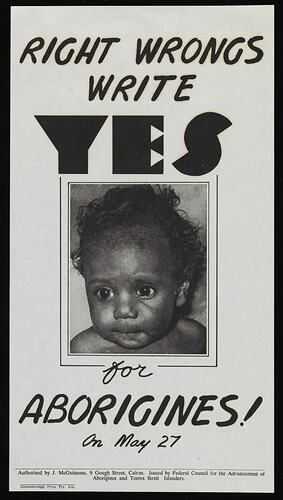Summary
On 27th May 1967 a referendum was held to address two sections in the Australian Constitution that discriminated against Aboriginal and Torres Strait Islander peoples, through their exclusion from federal laws and the national census. It was one hundred and seventy nine years into British colonisation of First Peoples where they were brutally controlled by state laws. After tireless campaigning, 90.77% of the public voted YES to amending the constitution.
This overwhelming response came from a belief that it would improve the lives of First Peoples. There are conflicting opinions on how it benefitted First Peoples communities, however the win for the referendum was a turning point in First Peoples rights. This led to a new wave of change makers calling for 'Black control of Black affairs' shifting the focus from inclusion, to First Peoples rights and land rights, a movement which continues today.
The 1967 referendum resulted from decades of advocacy. The 1930's saw the development of key political groups, the Aborigines Progressive Association in New South Wales and the Australian Aborigines League in Victoria. In 1956 the Australian Aboriginal Fellowship championed a petition to make amendments to the federal constitution, starting the trajectory to the 1967 referendum. The Aborigines Advancement League (AAL) was formed in 1957, and in 1958 the Federal Council of Aboriginal Affairs (FCAA later to become FCAATSI) - both crucial to making the campaign successful.
Physical Description
'Right the Wrongs Write YES for Aborigines May 27' was a poster used in the lead up to the 1967 referendum calling for the change to the Australian constitution that racially discriminated against Aboriginal and Torres Strait Islander peoples. This iconic image is now synonymous with the movement of the 67 referendum.
Significance
The campaign for a referendum was formally launched at a Federal Council of Aboriginal Affairs meeting in Sydney in 1962. The 'Right the Wrongs and Write Yes' slogan along with 'Vote Yes for Aborigines' was part of the 1967 Referendum Campaign which was included on thousands of handbills, car stickers, vote yes badges, literature and general information. Many First People campaigners - including Joe McGuiness, Bill Onus, Pearl Gibbs and Sir Pastor Doug Nicholls -travelled around the country speaking to individuals and at public forums on the referendum.
"We made it very clear that, as seen by us on the deputation, it was painfully ironical that while a census of sheep and cattle in the country was taken and the official popular number declared annually, the Aboriginal population was excluded from the exercise." - Joe McGuinness, activist and first Indigenous president of Federal Council of Aboriginal Affairs
More Information
-
Object/Medium
Poster
-
Date Produced
-
Number of Sheets
1
-
Number of Pages
1
-
Keywords
-
Type of item
-
Discipline
-
Category
-
Collecting Areas
Ethnohistory, Australian Indigenous - South-eastern Australia
Title
Right Wrongs Write Yes
